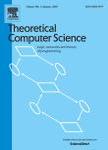版权所有:内蒙古大学图书馆 技术提供:维普资讯• 智图
内蒙古自治区呼和浩特市赛罕区大学西街235号 邮编: 010021

作者机构:George Mason Univ Dept Comp Sci Fairfax VA 22030 USA
出 版 物:《THEORETICAL COMPUTER SCIENCE》 (理论计算机科学)
年 卷 期:2013年第497卷
页 面:164-172页
核心收录:
学科分类:08[工学] 0812[工学-计算机科学与技术(可授工学、理学学位)]
基 金:National Science Foundation [CCF-0915681]
主 题:Online algorithm Competitive analysis Buffer management Packet scheduling
摘 要:We consider scheduling packets with values in a capacity-bounded buffer in an online setting. In this model, there is a buffer with limited capacity B. At any time, the buffer cannot accommodate more than B packets. Packets arrive overtime. Each packet has a non-negative value. Packets leave the buffer only because they are either sent or dropped. Those packets that have left the buffer will not be reconsidered for delivery any more. In each time step, at most one packet in the buffer can be sent. The order in which the packets are sent should comply with the order of their arrival time. The objective is to maximize the total value of the packets sent in an online manner. In this paper, we study a variant of this FIFO buffering model in which a packet s value is either 1 or alpha 1. We present a deterministic memoryless 1.304-competitive algorithm. This algorithm has the same competitive ratio as the one presented in Lotker and Patt-Shamir [Z. Lotker, B. Patt-Shamir, Nearly optimal FIFO buffer management for DiffServ, in: Proceedings of the 21st Annual ACM Symposium on Principles of Distributed Computing, PODC, 2002, pp. 134-142;Z. Lotker, B. Patt-Shamir, Nearly optimal FIFO buffer management for DiffServ, Computer Networks 17 (1) (2003) 77-89]. However, our algorithm is simpler and does not employ any marking bits. The idea used in our algorithm is novel and different from all previous approaches that have been applied for the general model and its variants. We do not proactively preempt one packet when a new packet arrives. Instead, we may preempt more than one 1-value packet at the time when the buffer contains sufficiently many alpha-value packets. (C) 2011 Elsevier B.V. All rights reserved.